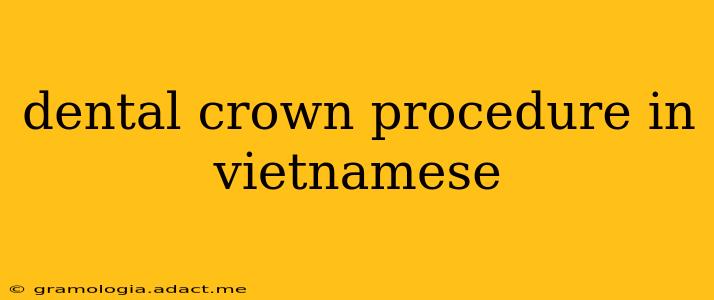Dental Crown Procedure in Vietnamese: A Comprehensive Guide
Getting a dental crown is a significant procedure, and understanding the process is crucial for peace of mind. This guide will walk you through the entire dental crown procedure, focusing specifically on the Vietnamese context, including potential costs and recovery.
What is a Dental Crown?
In Vietnamese, a dental crown is often referred to as a mão răng sứ (mão = crown; răng = tooth; sứ = porcelain). It's a cap placed over a damaged or weakened tooth to restore its shape, size, strength, and appearance. Dental crowns are commonly used to address various dental issues, including severely decayed teeth, fractured teeth, teeth with large fillings, and teeth that have undergone root canal treatment. They can be made from various materials, including porcelain, metal, or a combination of both. Porcelain crowns are highly aesthetically pleasing, closely mimicking the natural appearance of teeth.
The Dental Crown Procedure Step-by-Step (Quy trình làm mão răng sứ):
-
Initial Consultation and Examination (Khám và tư vấn ban đầu): This is where you'll discuss your dental concerns with the dentist. They'll examine your teeth, take X-rays (chụp X-quang), and determine if a crown is the appropriate treatment. They'll also explain the procedure, discuss the different materials available (vật liệu), and answer any questions you may have. In Vietnam, it's common to find dentists who speak both Vietnamese and English, particularly in larger cities.
-
Tooth Preparation (Chuẩn bị răng): The dentist will prepare the tooth by removing a layer of enamel (men răng) to create space for the crown. This process may involve local anesthesia (gây tê tại chỗ) to ensure comfort.
-
Impression Taking (Lấy dấu răng): A precise impression (dấu răng) of your prepared tooth will be made using a putty-like material. This impression is sent to a dental laboratory (phòng thí nghiệm nha khoa) where your custom crown will be crafted.
-
Temporary Crown Placement (Đặt mão răng tạm): While waiting for your permanent crown (thường 1-2 tuần), you'll be fitted with a temporary crown (mã răng tạm) to protect the prepared tooth and maintain its function.
-
Permanent Crown Cementation (Gắn mão răng vĩnh viễn): Once the permanent crown is ready, the dentist will remove the temporary crown, carefully check the fit and appearance, and permanently cement (gắn cố định) the new crown onto your prepared tooth.
-
Post-Procedure Check-ups (Khám lại sau khi làm mão): Follow-up appointments (khám định kỳ) are crucial to ensure the crown is fitting well and your gums are healthy.
H2: How Much Does a Dental Crown Cost in Vietnam? (Chi phí làm mão răng sứ ở Việt Nam là bao nhiêu?)
The cost of a dental crown in Vietnam varies greatly depending on several factors:
- Material: Porcelain crowns are generally more expensive than metal crowns. All-ceramic crowns offer the best aesthetics and are typically the most costly option.
- Dentist: Costs vary between clinics and dentists; those in larger cities or more specialized clinics tend to charge more.
- Complexity of the procedure: The complexity of the tooth preparation or any additional procedures needed can influence the cost.
It’s best to contact several dental clinics directly for accurate pricing information. You can expect a significant price difference compared to Western countries.
H2: What are the Risks and Complications? (Những rủi ro và biến chứng là gì?)
While generally safe, there are potential risks associated with dental crown procedures:
- Sensitivity: Some patients may experience temporary sensitivity (nhạy cảm) to temperature changes after the procedure.
- Irritation: Gums may become slightly irritated (viêm lợi) around the crown, but this usually subsides quickly.
- Crown breakage: A crown can break (vỡ mão) if subjected to excessive force (chịu lực quá mạnh).
- Infection: Though rare, infection (nhiễm trùng) is possible if proper hygiene isn't maintained.
It's vital to follow your dentist's post-operative instructions carefully to minimize these risks.
H2: How Long Does it Take to Get a Dental Crown? (Làm mão răng sứ mất bao lâu?)
The entire process usually takes several weeks, primarily due to the time it takes to create the custom crown in the dental laboratory. The initial appointment, tooth preparation, and temporary crown placement can all be done in one visit, but the permanent crown cementation requires a separate appointment.
H2: What is the Aftercare for Dental Crowns? (Chăm sóc sau khi làm mão răng sứ như thế nào?)
Proper aftercare is critical for the longevity of your crown. Follow your dentist's instructions meticulously, but generally, this involves:
- Maintaining excellent oral hygiene: Brush and floss thoroughly (chải răng và dùng chỉ nha khoa kỹ lưỡng) twice daily.
- Avoid hard or sticky foods: Be cautious (cẩn thận) when eating hard candies, nuts, or other foods that could potentially damage or dislodge your crown.
- Regular dental check-ups: Attend regular check-up appointments (khám định kỳ) with your dentist to monitor the crown’s condition and overall oral health.
This comprehensive guide provides a detailed overview of the dental crown procedure in a Vietnamese context. Remember to consult with your dentist for personalized advice and to address any specific concerns you may have.
